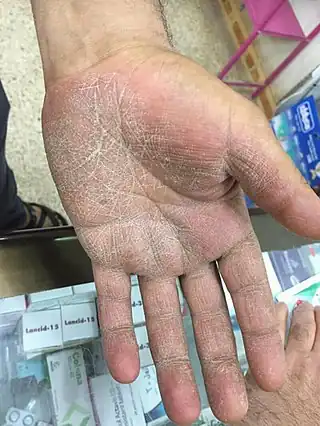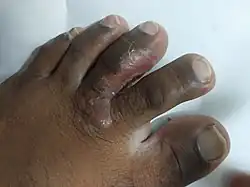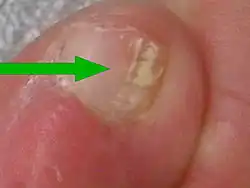Two feet-one hand syndrome
| Two feet-one hand syndrome | |
|---|---|
  | |
| Top:Athlete's foot (both feet) Bottom: Tinea manuum (one hand) | |
| Specialty | Dermatology, infectious diseases |
| Symptoms | Diffuse scaling of palms and prominent palmer creases in one hand, tinea pedis in both feet[1] |
| Complications | Secondary bacterial infection[2] |
| Duration | Tendency to last longterm[3] |
| Causes | Trichophyton rubrum[3] |
| Risk factors | Excessive sweating[4] |
| Diagnostic method | Visualization, microscopy, culture[4] |
| Differential diagnosis | Dermatitis, psoriasis, keratoderma, hyperkeratosis, allergic contact dermatitis[5] |
| Prevention | Foot hygiene,[4] avoid scratching feet and toes[6] |
| Treatment | Antifungals[4] |
| Medication | Oral terbinafine, itraconazole, fluconazole, griseofulvin[4] |
| Frequency | Males>females[3] |
Two feet-one hand syndrome (TFOHS), is a long-term fungal condition where athlete's foot or fungal toe nail infections in both feet is associated with tinea manuum in one hand.[3][7] Often the feet are affected for several years before symptoms of a diffuse scaling rash on the palm of one hand appear, which is when most affected people then seek medical help.[7]
The most common causative organism is Trichophyton rubrum.[3] The condition is more likely to occur in people who sweat more.[4] Diagnosis is by visualization, microscopy and culture.[4] It may appear similar to dermatitis, psoriasis, keratoderma, hyperkeratosis and allergic contact dermatitis.[5] Treatment is with long-term systemic antifungals, typically oral terbinafine or itraconazole.[4][8]
The condition is frequently seen in skin clinics.[9] Males are affected more frequently than females.[3] One study showed that 65% of cases with tinea manuum were part of TFOHS.[6][10] TFOHS was first described by Curtis in 1964.[11]
Signs and symptoms
TFOHS is a long-term fungal condition where athlete's foot or fungal toe nail infections in both feet is associated with tinea manuum in one hand.[3][7] It typically presents with a diffuse scaling rash on the palm of one hand, which is preceded, sometimes by several years, by fungal infection in both feet.[3] palmer creases appear prominent.[1] There is typically a sharp demarcation at the wrist.[12] Signs in a hand therefore require an examination of feet.[13]
.jpg.webp) Athlete's foot (interdigital)
Athlete's foot (interdigital) Athlete's foot (interdigital)
Athlete's foot (interdigital)
.jpg.webp) Tinea manuum with nail involvement
Tinea manuum with nail involvement.jpg.webp) Tinea manuum (palm)
Tinea manuum (palm)
Cause and mechanism
TFOHS may follow scratching feet infected by fungi or occur after a pedicure.[3] The most common causative organism is Trichophyton rubrum.[3][2] Typically, the hand that is used to scratch the infected feet or toes is the one that contracts tinea manuum.[14] Why the other hand is spared is not clear.[15][16] In a case-control study that also looked at scratching habits, despite concluding that it was likely that tinea manuum develops in the hand that scratches the feet, some cases of TFOHS occurred in the hand that did not scratch the feet.[9]
Risk factors are the same as for athlete's foot and include excessive sweating and weakened immune system.[4][6] Reinfection from contaminated socks may be possible.[4]
Diagnosis
Diagnosis of TFOHS is by visualisation, microscopy and culture from skin scrapings of the edge of the rash.[2][11] The condition may appear similar to dermatitis, psoriasis, keratoderma, hyperkeratosis and allergic contact dermatitis.[5] It is sometimes misdiagnosed as hand eczema.[17] Id reaction may appear similar.[18]
Treatment
Treatment is with long-term systemic antifungals, typically oral terbinafine at a dose of 250mg/day for upto 2 weeks, itraconazole at a dose of 200mg twice daily for a week, fluconazole at a dose of 150mg weekly for a month, or griseofulvin at a dose of 500-1000mg/day for adults and 10-20mg/kg/day for children.[4]
Prevention is focused on hygiene measures such as keeping feet dry and applying antiseptic powder.[4] Using intermittent antifungal treatment in susceptible people, and avoiding scratching the feet or picking at fungal toenail infections are further preventative measures.[6] Avoiding washing socks in cold water may help, as well as dusting feet with Tolnaftate powder.[4] Dusting socks with talc, cornstarch or rice powder may help keep feet dry.[4]
Epidemiology
It is not known how many people have TFOHS.[6] Males are affected more frequently than females.[3] Athlete's foot is the most common fungal disease, with possibly more than 50% of the population affected at some time.[2][4] Tinea manuum accounts for less than 2% of all superficial fungal infections.[2] Tinea manuum is rare in both hands.[2] Scenarios with one foot and two hands, and one foot and one hand, have been described.[15] One study showed that 65% of cases with tinea manuum were part of TFOHS.[6]
History
The condition was first described by Curtis in 1964.[11] It was later designated a syndrome.[11]
References
- 1 2 Johnstone, Ronald B. (2017). "25. Mycoses and Algal infections". Weedon's Skin Pathology Essentials (2nd ed.). Elsevier. p. 441. ISBN 978-0-7020-6830-0. Archived from the original on 2021-05-25. Retrieved 2021-09-26.
- 1 2 3 4 5 6 Schachtel, April; DeNiro, Katherine L. (2021). "22. Superficial dermatophyte infections of the skin". In Jong, Elaine C.; Stevens, Dennis L. (eds.). Netter's Infectious Diseases (Second ed.). Philadelphia: Elsevier. pp. 101–102. ISBN 978-0-323-71159-3. Archived from the original on 2021-09-29. Retrieved 2021-09-29.
- 1 2 3 4 5 6 7 8 9 10 11 Ginter-Hanselmayer, Gabriele; Nenoff, Pietro (2018). "10. Clinically Relevant Mycoses Dermatomycoses". In Presterl, Elisabeth (ed.). Clinically Relevant Mycoses: A Practical Approach. Springer. p. 154. ISBN 978-3-319-92299-7. Archived from the original on 2021-09-27. Retrieved 2021-09-26.
- 1 2 3 4 5 6 7 8 9 10 11 12 13 14 15 James, William D.; Elston, Dirk; Treat, James R.; Rosenbach, Misha A.; Neuhaus, Isaac (2020). "15. Diseases resulting from fungi and yeasts". Andrews' Diseases of the Skin: Clinical Dermatology (13th ed.). Elsevier. pp. 297–299. ISBN 978-0-323-54753-6. Archived from the original on 2021-10-03. Retrieved 2021-10-03.
- 1 2 3 Russell, James D.; McCall, Calvin O. (2015). "17. Infections in the kidney transplant recipient". In Nunley, Julia R.; Lerma, Edgar V. (eds.). Dermatological Manifestations of Kidney Disease. New York: Springer. p. 175. ISBN 978-1-4939-2394-6. Archived from the original on 2021-10-13. Retrieved 2021-10-15.
- 1 2 3 4 5 6 Chamorro, Monica J.; House, Steven A. (10 August 2020). "Tinea Manuum". StatPearls. StatPearls Publishing. PMID 32644474. Archived from the original on 29 August 2021. Retrieved 15 October 2021.
- 1 2 3 Rubin, Adam I.; Jellinek, Nathaniel J.; III, C. Ralph Daniel; Scher, Richard K. (2018). "9. Onychomycosis". Scher and Daniel's Nails: Diagnosis, Surgery, Therapy. Springer. p. 157. ISBN 978-3-319-65649-6. Archived from the original on 2021-09-27. Retrieved 2021-09-26.
- ↑ Habif, Thomas P. (2016). "13. Superficial fungal infections". Clinical Dermatology (Sixth ed.). Elsevier. p. 492. ISBN 978-0-323-26183-8. Archived from the original on 2021-10-15. Retrieved 2021-10-15.
- 1 2 Acton, Ashton (2011). Advances in Tinea Research and Treatment: 2011 Edition: ScholarlyPaper. ScholarlyEditions. p. 3. ISBN 978-1-4649-5597-6. Archived from the original on 2021-10-15. Retrieved 2021-10-15.
- ↑ Zhan, Ping; Geng, Chengfang; Li, Zhihua; Jiang, Qing; Jin, Yun; Li, Caixia; Liu, Weida (August 2013). "The epidemiology of tinea manuum in Nanchang area, South China". Mycopathologia. 176 (1–2): 83–88. doi:10.1007/s11046-013-9673-9. ISSN 1573-0832. PMID 23765324. Archived from the original on 2021-08-29. Retrieved 2021-10-15.
- 1 2 3 4 Bjekić, Milan (1 September 2015). "Two Feet-One Hand Syndrome: A Case Report / Sindrom dva stopala i jedne šake – prikaz slučaja". Acta Facultatis Medicae Naissensis. 32 (3): 215–219. doi:10.1515/afmnai-2015-0022.
- ↑ Marks (Jr.), James G.; Miller (Dermatologist), Jeffrey J. (2013). Lookingbill and Marks' Principles of Dermatology. Elsevier Health Sciences. p. 114. ISBN 978-1-4557-5014-6. Archived from the original on 2021-10-15. Retrieved 2021-10-15.
- ↑ Goodheart, Herbert P. (2010). Goodheart's Same-site Differential Diagnosis: A Rapid Method of Diagnosing and Treating Common Skin Disorders. Lippincott Williams & Wilkins. p. 187. ISBN 978-1-60547-746-6. Archived from the original on 2021-10-04. Retrieved 2021-10-15.
- ↑ Richardson, Malcolm D.; Warnock, David W. (2012). Fungal Infection: Diagnosis and Management. John Wiley & Sons. p. 111. ISBN 978-1-4051-7056-7. Archived from the original on 2021-10-15. Retrieved 2021-10-15.
- 1 2 Bikowski, Joseph (February 2014). "Update on Management of Dermatophytoses". Practical Dermatology: 23-26. Archived from the original on 2021-10-04. Retrieved 2021-10-15.
- ↑ Elston, Dirk (2009). "2. Fungal infections". Infectious Diseases of the Skin. Boca Raton: Manson publishing. p. 44. ISBN 978-1-84076-514-4. Archived from the original on 2021-10-15. Retrieved 2021-10-15.
- ↑ Lachapelle, Jean-Marie; Tennsdedt, Dominique (2014). "5. Other dermatoses affecting the hand: differential diagnosis". In Alikhan, Ali; Lachapelle, Jean-Marie; Maibach, Howard I. (eds.). Textbook of Hand Eczema. Springer. pp. 66–67. ISBN 978-3-642-39545-1. Archived from the original on 2021-10-04. Retrieved 2021-10-15.
- ↑ Bolognia, Jean L.; Jorizzo, Joseph L.; Rapini, Ronald P. (2003). Dermatology. Mosby. pp. 1208–1209. ISBN 0-32302-4092. Archived from the original on 2021-10-17. Retrieved 2021-10-16.